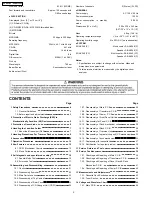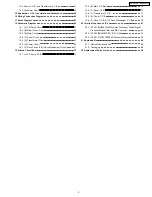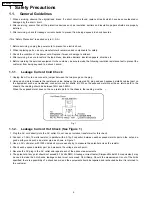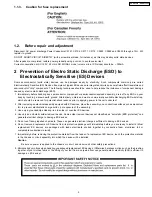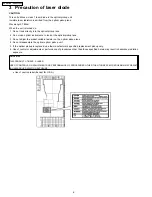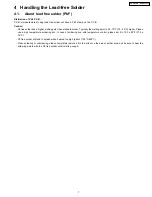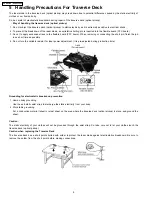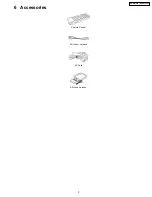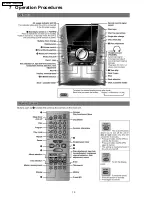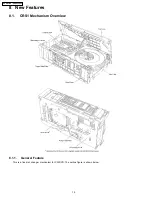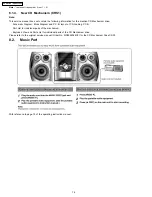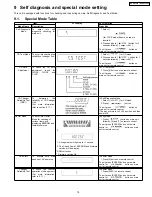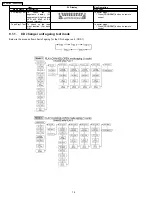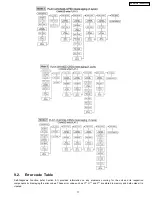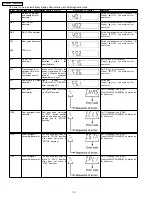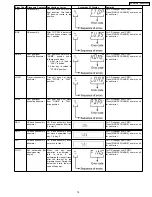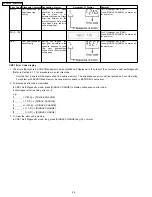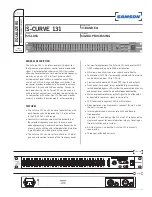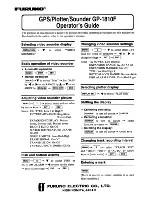
1.1.3. Caution for fuse replacement
1.2. Before repair and adjustment
Disconnect AC power, discharge Power Capacitors C5101, C5104, C5171, C5172, C5920, C5940 and C5950 through a 10
Ω
, 5W
resistor to ground.
DO NOT SHORT-CIRCUIT DIRECTLY (with a screwdriver blade, for instance), as this may destroy solid state devices.
After repairs are completed, restore power gradually using a variac, to avoid overcurrent.
Current consumption at AC 120V, 60 Hz in NO SIGNAL mode (volume min at CD mode) should be ~ 300mA.
2 Prevention of Electro Static Discharge (ESD) to
Electrostatically Sensitive (ES) Devices
Some semiconductor (solid state) devices can be damaged easily by electricity. Such components commonly are called
Electrostatically Sensitive (ES) Devices. Examples of typical ES devices are integrated circuits and some field-effect transistors and
semiconductor “chip” components. The following techniques should be used to help reduce the incidence of component damage
caused by electro static discharge (ESD).
1. Immediately before handling any semiconductor component or semiconductor-equiped assembly, drain off any ESD on your
body by touching a known earth ground. Alternatively, obtain and wear a commercially available discharging ESD wrist strap,
which should be removed for potential shock reasons prior to applying power to the unit under test.
2. After removing an electrical assembly equiped with ES devices, place the assembly on a conductive surface such as aluminium
foil, to prevent electrostatic charge build up or exposure of the assembly.
3. Use only a grounded-tip soldering iron to solder or unsolder ES devices.
4. Use only an anti-static solder remover device. Some solder removal devices not classified as “anti-static (ESD protected)” can
generate electrical charge to damage ES devices.
5. Do not use freon-propelled chemicals. These can generate electrical charges sufficient to damage ES devices.
6. Do not remove a replacement ES device from its protective package until immediately before you are ready to install it. (Most
replacement ES devices are packaged with leads electrically shorted together by conductive foam, aluminium foil or
comparable conductive material).
7. Immediately before removing the protective material from the leads of a replacement ES device, touch the protective material
to the chassis or circuit assembly into which the device will be installed.
Caution
Be sure no power is applied to the chassis or circuit, and observe all other safety precautions.
8. Minimize body motions when handling unpackaged replacement ES devices. (Otherwise harmless motion such as the brushing
together of your clothes fabric or the lifting of your foot from a carpeted floor can generate static electricity (ESD) sufficient to
damage an ES device).
5
SA-AK340P / SA-AK340PC
Summary of Contents for SA-AK340P
Page 9: ...6 Accessories Remote Control FM Indoor Antenna AC Cord AM Loop Antenna 9 SA AK340P SA AK340PC ...
Page 10: ...7 Operation Procedures 10 SA AK340P SA AK340PC ...
Page 11: ...11 SA AK340P SA AK340PC ...
Page 23: ...10 3 Main Parts Location 23 SA AK340P SA AK340PC ...
Page 34: ...34 SA AK340P SA AK340PC ...
Page 40: ...12 2 Checking and Repairing of Transformer P C B 40 SA AK340P SA AK340PC ...
Page 41: ...12 3 Checking and Repairing of Panel Deck Deck Mechanism P C B 41 SA AK340P SA AK340PC ...
Page 42: ...12 4 Checking and Repairing of Power P C B 42 SA AK340P SA AK340PC ...
Page 47: ...14 2 Power P C B and Transformer P C B 47 SA AK340P SA AK340PC ...
Page 48: ...14 3 Waveform Chart 48 SA AK340P SA AK340PC ...
Page 56: ...56 SA AK340P SA AK340PC ...
Page 58: ...SA AK340P SA AK340PC 58 ...
Page 60: ...SA AK340P SA AK340PC 60 ...
Page 66: ...SA AK340P SA AK340PC 66 ...
Page 68: ...SA AK340P SA AK340PC 68 ...
Page 72: ...SA AK340P SA AK340PC 72 ...
Page 80: ...SA AK340P SA AK340PC 80 ...
Page 84: ...84 SA AK340P SA AK340PC ...
Page 85: ...21 Exploded Views 21 1 Cabinet Parts Location SA AK340P SA AK340PC 85 ...
Page 86: ...SA AK340P SA AK340PC 86 ...
Page 87: ...SA AK340P SA AK340PC 87 ...


